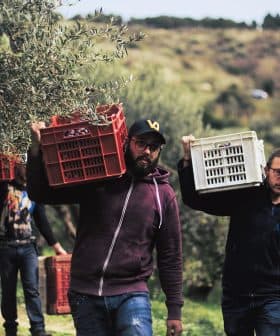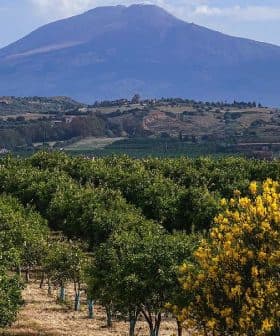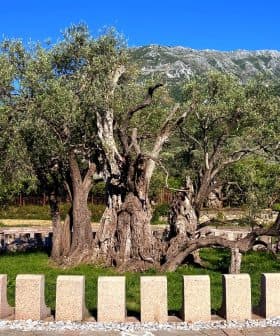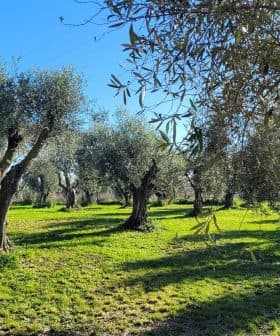The World's Commercial Olive Groves Are Shrinking
The shift to super-intensive cultivation, low prices for olives and olive oil, and the surplus on the international market were identified as factors that led to the reversal of a decades-long trend.
The global surface area of olive trees cultivated for commercial purposes has decreased for the first time in 22 years, with drops noted in countries like Italy, Spain, Greece, Jordan, and Syria. Factors contributing to this decline include growers switching to more profitable crops like almonds and walnuts, the rise of modern olive tree cultivation, and the oversupply of olive oil in the international market.
For the first time in 22 years, the global surface area of olive trees that are cultivated for commercial purposes has decreased.
The largest drop has been noted in Italy, Spain, Greece, Jordan and Syria, all of which are countries where the internal consumption of olives and olive oil have decreased.
Prices are the incentive for crop development… As prices improve and the crop becomes more profitable, the trend may change.
“The international olive cultivation surface area has grown over the last two decades with more than a million hectares (2.47 million acres), mainly with modern cultivation – intensive and super-intensive – and the countries in which olives are cultivated grew from 46 to 65,” Juan Vilar Hernández, an industry analyst and professor at the University of Jaén, told Olive Oil Times.
“In 22 years, this is the first year in which the international olive tree surface decreased,” he added.
See Also:Olive Tree Cultivation NewsVilar and Jorge Enrique Pereira Benítez, an olive oil consultant and professor of agronomy, found this reversal in the decades-long trend while updating their co-authored olive cultivation manual, International Olive Growing: Worldwide Analysis and Summary.
Vilar clarified that for the purposes of the study, the global surface area is where olive trees are cultivated for commercial purposes. Olive trees that have been abandoned or not used for commercial purposes are not included in the international tree surface area figure, even if the trees are still alive.
One of the main reasons for the shrinking surface area is that growers are switching to more profitable options, such as growing almond and walnut trees.
“Now (that) international oliviculture is a mature market… companies are increasing the surface in which they are cultivating almond trees,” he said.
Vilar expects the market for almonds to continue increasing for the next eight to 10 years.
The second factor that Vilar and Pereira identified as causing the world’s commercial olive groves to shrink is that modern olive tree cultivation is overtaking traditional oliviculture.
Traditional olive cultivation – which makes up 70 percent of the global olive tree surface area – cannot compete with intensive and super-intensive olive tree cultivation.
“More than 70 percent of the international olive tree surface is losing money,” Vilar said.
The third reason for the decrease that the pair identified is that the international stock of olive oil in the world is at its highest point ever.
When the manual was finalized in 2018, 58 olive-growing countries were noted. Vilar said that despite the decrease of the global surface area, the number of olive-growing countries, which were noted by the more than 300 researchers that contributed to the manual, has increased to 65 countries this year.
San Marino, Canada, Eritrea, Oman, the United Arab Emirates and Ukraine are among the most recent countries to be added.
Pereira said that there was not a sudden increase in olive producing countries. In fact, some of these countries have been growing olive trees for a few years, but the researchers for the reference guide only recently became aware of them.
He added that in some parts of the world, more commercial olive groves are also being grown, such as in North Africa, China, the United States and Brazil.
Vilar explained that the general increase in olive growing countries is due to the availability of cheap land for agriculture outside of Europe.
“None of the largest olive tree farms are in Europe,” he said.
The sheer scale of these farms coupled with the low cost of production made them highly profitable. Vilar added that in some of these newly minted olive grove hubs oliviculture is introduced by the people moving from countries, such as Greece, Spain and Italy.
One of the factors that the guide does not identify is impacting global olive grove surface area was Xylella fastidiosa, in spite of the havoc it has brought to Puglia.
“The influence of Xylella fastidiosa is mainly in the south of Italy,” Vilar said.
He added that Xylella poses a more serious threat when olive trees are abandoned. These give the insect vectors the opportunity to spread the disease from olive tree to olive tree unimpeded, which he said is a real risk.
However, Pereira said that Xylella played a direct role in the decrease of the olive grove area in Italy.
“Between five and eight million olive trees have been lost in the Puglia region,” he said, “which together with the climatic effects, has led to the production of olive oil that is 40 percent lower than previous years.”
Looking to the future, both Pereira said that this decrease in commercial olive grove surface area will last as long as olive oil prices remain low in major producing countries, such as Spain.
“Prices are the incentive for crop development,” Pereira said. “The trend in Spain is low prices, so there are producers who abandon olive groves. As prices improve and the crop becomes more profitable, the trend may change.”
Vilar added that he believes the decrease in the global olive surface area is temporary.
“In traditional olive-growing countries many olive farmers are either retired people or people with other jobs who farm commercially over weekends and holidays,” he said.
“When prices for olive products recover, these farmers will once again start cultivating their groves,” he added. “[However], some groves, for instance, those located in the mountain and so forth, will be permanently abandoned.”









